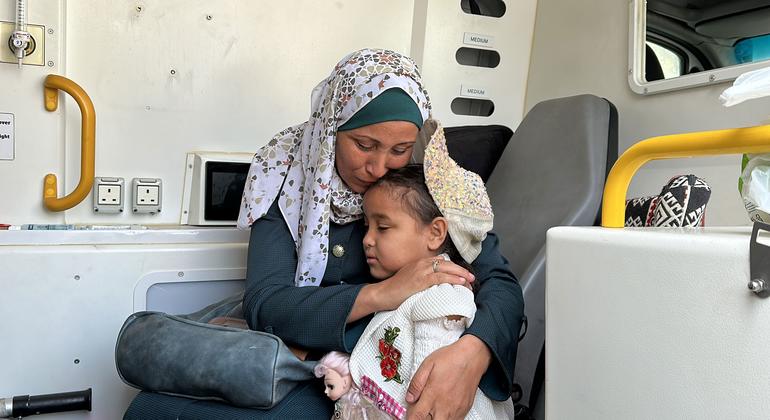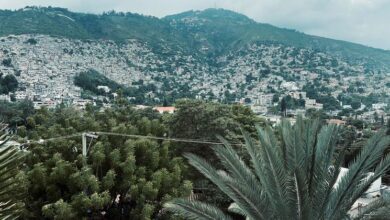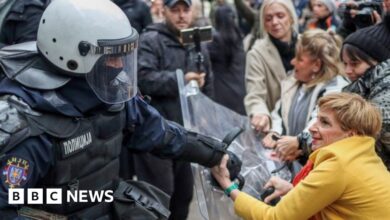Where do I go now, ask Gazans displaced by new Israeli evacuation order


In Khan Younis, the United Nations agency for Palestinian refugees (UNRWA) reported witnessing “thousands of people fleeing” west as part of an exodus from the southern city of the enclave amid ongoing fighting, leaving children traumatized and crying incessantly.
“Old people on donkey carts… disabled people pushed in wheelchairs across the sand with their belongings piled on their laps,” said Louise Wateridge, Senior Communications Officer for UNRWA. “People were running, heard gunshots [and] run for your life. Families are really just taking what they can hold in their hands… People don’t know where to go. That’s the main question people are asking today, ‘Where am I going to go?’”
Al Mawasi is shrinking
Israeli evacuation orders also affected about 8.7 square kilometers of land in the so-called Al Mawasi “humanitarian zone,” located on the coast near Khan Younis, reducing its size by nearly 15 percent. According to the United Nations Office for the Coordination of Humanitarian Affairs, OCHA.
“Initial reports indicate that families are now moving to areas in Deir al Balah and west of Khan Younis,” OCHA said. “Both areas are already overcrowded, with limited shelter and services and barely able to accommodate the influx of displaced people..
As of July 22, nearly 83 percent of the Gaza Strip had been ordered evacuated or designated as a “no-go zone” by the Israeli military.
UN human rights office condemns
Condemning “repeated” evacuation orders, UN human rights office OHCHRstressed that the Israeli military “did not give civilians time” to understand where they had to leave or where they should go.
At least 70 Palestinians, including women and children, were killed in the ongoing violence on Monday, the UN human rights office said, citing local medical authorities. At least 200 others were also injured, some in critical condition, amid reports of increased Israeli air strikes in Khan Younis since Sunday, with “multiple” airstrikes on Monday and “intensified” shelling in the east of the city.
“Israeli military operations continue unabated in and around the area,” OHCHR said, noting that the evacuation order included parts of the Salah al-Deen Road – “one of the two main routes critical for the transport and distribution of aid, raising concerns that the supply and delivery of much-needed humanitarian aid will continue to be curtailed or blocked.”
UNICEF vehicle hit by live bullet
Two are clearly marked UNICEF The UN Children’s Fund said the vehicles were hit by live fire while waiting at a designated holding point near Wadi Gaza on Tuesday.
“They were on their way to reunite five children, including a baby, with their father,” the agency’s regional director added, in a post on X.
“A car was hit by three bullets but luckily there were no injuries,” Adele Khodr said.
This is the second shooting involving a UNICEF vehicle in the past 12 weeks, and the Palestinian refugee agency UNRWA was also hit by a similar incident on Sunday, the UN spokesman recalled at a regular noon press briefing in New York.
“We strongly affirm that humanitarian workers are protected under international humanitarian law and must not be targeted,” Ms. Khodr continued.
UNICEF also reported that it had delivered several water pipes to northern Gaza on Monday to supply water to the Jabalya area.
Polio alert update
Meanwhile, concerns continue to grow about the impact of a polio outbreak in Gaza, amid dire sanitation conditions and lack of access to health care.
Dr. Ayadil Saparbekov, Head of Health Emergencies at the United Nations World Health Organization (WHO) in the Occupied Palestinian Territories, said on Tuesday that he was “extremely worried” about The spread of polio and other infectious diseases, which may result in more deaths from preventable diseases than from war-related injuries.
Hepatitis A was confirmed in the Gaza Strip last year, he told journalists via video link from Jerusalem.
“With a crippled health system, a lack of water and sanitation, and a population without access to health services… this is going to be a very bad situation,” he said. “We could have more people dying from various infectious diseases than from injury-related conditions.”
On July 16, WHO said vaccine-derived poliovirus type 2 (VDPV2) was detected at six sites in wastewater samples collected on June 23 from Khan Younis and Deir Al-Balah.
Last week, the WHO explained that polio virus can emerge in areas with low vaccination rates, allowing a weaker form of the oral vaccine virus to mutate into a stronger version.
So far, the virus has only been found in wastewater samples, and no one in Gaza has been identified as having contracted paralytic polio. Further genome sequencing by the U.S. Centers for Disease Control and Prevention (CDC) in Atlanta showed that the virus was related to a strain circulating in Egypt in the second half of 2023, the WHO said.
Dr Saparbekov explained that human samples have not yet been collected, due to a lack of equipment and laboratory capacity to test them. A WHO team will arrive in Gaza on Thursday with up to 50 sample collection kits; they will send these samples to a laboratory in Jordan for further analysis.
WHO officials said that together with partners, the agency is conducting an epidemiological investigation and risk assessment to determine the source of the virus that has a high risk of spreading in Gaza and internationally.
“Based on the assessment results, WHO and [Global Polio Initiative Network] The partners will consolidate a series of recommendations, including the need for a mass vaccination campaign,” he said.
Dr Saparbekov stressed that given the water, sanitation and hygiene situation in Gaza, it would be “very difficult” for people to follow advice on handwashing and safe drinking water.
“Unfortunately, the majority of people living in shelters with one toilet for 600 people and maybe only 1.52 litres of water per person will certainly not be able to follow these recommendations,” he said.
The representative of the UN health agency also stressed that if a mass vaccination campaign is decided, COGAT, the Israeli agency responsible for the flow of aid into Gaza, will be responsible for facilitating the delivery of vaccines. into the wilderness.
He added that WHO “has so far received assurances that this will be done”.
Health care system closed
Speaking about the devastation of Gaza’s health system, Dr Saparbekov said that less than half of primary health care facilities were functioning and only 16 of the enclave’s 36 hospitals were “partially functioning”, meaning they provided only minimal health care services such as triaging the wounded.
On Monday, WHO and partners conducted a mission to Al-Shifa Hospital in Gaza City, where they are renovating the outpatient department that was demolished in March 2024 and converting it into an emergency department.
“The only working device is unfortunately still in Gaza. [at Al Shifa hospital] “It was a stationary X-ray machine,” said Dr. Saparbekov. “All the other major equipment in the hospital, such as ventilators, anesthesia machines, operating room equipment, were unfortunately destroyed and needed to be replaced.”
He said WHO and partners were “working around the clock” to ensure that much-needed equipment was brought into Gaza despite “dual-use list restrictions”, meaning items are banned from entering the enclave because Israeli authorities believe they could be repurposed for military purposes.




